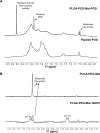Conjugation of cell-penetrating peptides with poly(lactic-co-glycolic acid)-polyethylene glycol nanoparticles improves ocular drug delivery
- PMID: 25670897
- PMCID: PMC4315550
- DOI: 10.2147/IJN.S71198
Conjugation of cell-penetrating peptides with poly(lactic-co-glycolic acid)-polyethylene glycol nanoparticles improves ocular drug delivery
Abstract
In this work, a peptide for ocular delivery (POD) and human immunodeficiency virus transactivator were conjugated with biodegradable poly(lactic-co-glycolic acid) (PGLA)-polyethylene glycol (PEG)-nanoparticles (NPs) in an attempt to improve ocular drug bioavailability. The NPs were prepared by the solvent displacement method following two different pathways. One involved preparation of PLGA NPs followed by PEG and peptide conjugation (PLGA-NPs-PEG-peptide); the other involved self-assembly of PLGA-PEG and the PLGA-PEG-peptide copolymer followed by NP formulation. The conjugation of the PEG and the peptide was confirmed by a colorimetric test and proton nuclear magnetic resonance spectroscopy. Flurbiprofen was used as an example of an anti-inflammatory drug. The physicochemical properties of the resulting NPs (morphology, in vitro release, cell viability, and ocular tolerance) were studied. In vivo anti-inflammatory efficacy was assessed in rabbit eyes after topical instillation of sodium arachidonate. Of the formulations developed, the PLGA-PEG-POD NPs were the smaller particles and exhibited greater entrapment efficiency and more sustained release. The positive charge on the surface of these NPs, due to the conjugation with the positively charged peptide, facilitated penetration into the corneal epithelium, resulting in more effective prevention of ocular inflammation. The in vitro toxicity of the NPs developed was very low; no ocular irritation in vitro (hen's egg test-chorioallantoic membrane assay) or in vivo (Draize test) was detected. Taken together, these data demonstrate that PLGA-PEG-POD NPs are promising vehicles for ocular drug delivery.
Keywords: anti-inflammatory; controlled release; flurbiprofen; ocular tolerance; peptide for ocular delivery.
Figures






Similar articles
-
Polydopamine-based surface modification for the development of peritumorally activatable nanoparticles.Pharm Res. 2013 Aug;30(8):1956-67. doi: 10.1007/s11095-013-1039-y. Epub 2013 Apr 23. Pharm Res. 2013. PMID: 23609560 Free PMC article.
-
Synthesis, characterization, and evaluation of paclitaxel loaded in six-arm star-shaped poly(lactic-co-glycolic acid).Int J Nanomedicine. 2013;8:4315-26. doi: 10.2147/IJN.S51629. Epub 2013 Nov 7. Int J Nanomedicine. 2013. PMID: 24235829 Free PMC article.
-
Effect of different molecular weight PLGA on flurbiprofen nanoparticles: formulation, characterization, cytotoxicity, and in vivo anti-inflammatory effect by using HET-CAM assay.Drug Dev Ind Pharm. 2020 Apr;46(4):682-695. doi: 10.1080/03639045.2020.1755304. Epub 2020 Apr 23. Drug Dev Ind Pharm. 2020. PMID: 32281428
-
PLGA-based nanoparticles as cancer drug delivery systems.Asian Pac J Cancer Prev. 2014;15(2):517-35. doi: 10.7314/apjcp.2014.15.2.517. Asian Pac J Cancer Prev. 2014. PMID: 24568455 Review.
-
Drug Delivery Nanoparticles: Toxicity Comparison in Retinal Pigment Epithelium and Retinal Vascular Endothelial Cells.Semin Ophthalmol. 2016;31(1-2):1-9. doi: 10.3109/08820538.2015.1114865. Semin Ophthalmol. 2016. PMID: 26959123 Free PMC article. Review.
Cited by
-
Peptidomimetics Therapeutics for Retinal Disease.Biomolecules. 2021 Feb 24;11(3):339. doi: 10.3390/biom11030339. Biomolecules. 2021. PMID: 33668179 Free PMC article. Review.
-
Effective In Vivo Topical Delivery of siRNA and Gene Silencing in Intact Corneal Epithelium Using a Modified Cell-Penetrating Peptide.Mol Ther Nucleic Acids. 2019 Sep 6;17:891-906. doi: 10.1016/j.omtn.2019.07.017. Epub 2019 Aug 1. Mol Ther Nucleic Acids. 2019. PMID: 31476668 Free PMC article.
-
Novel PEG-Modified Hybrid PLGA-Vegetable Oils Nanostructured Carriers for Improving Performances of Indomethacin Delivery.Polymers (Basel). 2018 May 24;10(6):579. doi: 10.3390/polym10060579. Polymers (Basel). 2018. PMID: 30966613 Free PMC article.
-
Lipid Vesicles Loaded with an HIV-1 Fusion Inhibitor Peptide as a Potential Microbicide.Pharmaceutics. 2020 May 31;12(6):502. doi: 10.3390/pharmaceutics12060502. Pharmaceutics. 2020. PMID: 32486415 Free PMC article.
-
Novel Tissue-Specific Multifunctionalized Nanotechnological Platform Encapsulating Riluzole Against Motor Neuron Diseases.Int J Nanomedicine. 2025 Feb 21;20:2273-2288. doi: 10.2147/IJN.S479819. eCollection 2025. Int J Nanomedicine. 2025. PMID: 40007904 Free PMC article.
References
-
- Brown RM, Roberts CW. Preoperative and postoperative use of non-steroidal antiinflammatory drugs in cataract surgery. Insight. 1996;21(1):13–16. - PubMed
-
- Bandara BM, Sankaridurg PR, Willcox MD. Non-steroidal anti inflammatory agents decrease bacterial colonisation of contact lenses and prevent adhesion to human corneal epithelial cells. Curr Eye Res. 2004;29(4–5):245–251. - PubMed
-
- Zhang W, Prausnitz MR, Edwards A. Model of transient drug diffusion across cornea. J Control Release. 2004;99(2):241–258. - PubMed
-
- Pignatello R, Bucolo C, Spedalieri G, Maltese A, Puglisi G. Flurbiprofen-loaded acrylate polymer nanosuspensions for ophthalmic application. Biomaterials. 2002;23(15):3247–3255. - PubMed
Publication types
MeSH terms
Substances
LinkOut - more resources
Full Text Sources
Other Literature Sources
Miscellaneous

